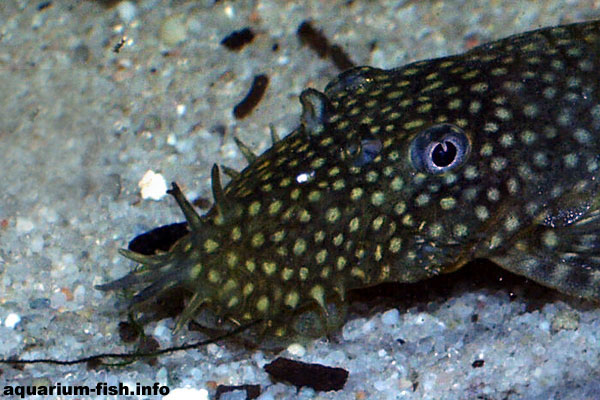

Species Profile | Images | Breeding Report | Similar Species
300.jpg)
(Other members of the genus Ancistrus)
ADULT SIZE: 5 cm
WATER CONDITIONS: Not critical
TEMPERATURE RANGE: 24-28 C
FOOD: Feed Ancistrus temmincki live and dried foods
DISTRIBUTION: This species comes from French Guiana, Surinam
SEXUAL DIFFERENCES: Both males and females show some facial bristling, but this is certainly more pronounced in male fish.
AQUARIUM CARE: A small catfish inhabiting many waters in South America. Tanks should be decorated as such with plants and wood. They will clean up algae in the tank but it is important to also include a vegetable component in the diet, such as cucumber, blanched peas etc. Males have distict bristling on the nose - this is far less pronounced in the female
These small catfish make great companions to many other species; they are peaceful, don't grow too large and tolerant a wide range of conditions. An ideal community tank species. Make sure to include some bogwood under which to hide, and rasp upon also.
BREEDING: Breeding is not difficult with the right tank set-up. A well-fed pair will often breed in a community tank. Males select a spawning site, on bogwood or in an upturned flower pot, where eggs will be laid. He will continue to guard/fan the eggs until hatching, and for the first week or so afterwards.
Have you bred Ancistrus temmincki? Why not fill in a breeding questionaire?, or examine existing Ancistrus temmincki breeding reports
Other members of the genus Ancistrus
Other catfish species
Other species from French Guiana, Surinam
b.jpg)
Ancistrus temmincki, or Temmincks bristlenose - males sport a bristly nose

This young males bristles will get longer than this
b.jpg)
Like most catfish, Ancistrus temmincki feeds by rasping a substrate: bogwood stone, or just the aquarium glass
BREEDING: Breeding is not difficult with the right tank set-up. A well-fed pair will often breed in a community tank. Males select a spawning site, on bogwood or in an upturned flower pot, where eggs will be laid. He will continue to guard/fan the eggs until hatching, and for the first week or so afterwards.
Have you bred Ancistrus temmincki? Why not fill in a breeding questionaire?
This page summarises breeding reports provided by visitors to this site, along with some statistical analysis. Please feel free to contribute - whatever your experience!
| |||||||||
|
| ||||||||
|
| ||||||||
| |||||||||
|
| ||||||||
Remember, each record represents only one persons experience; if you had different results, or used different methods, please share your experiences
| Water conditions: Neutral | Water temperature: 28oC+ |
| Disposition: Active, but not aggresive | Community tank?: Yes, a good community fish |
| Spawning Method: Other (see below) | Breeding problems: none |
| Sex ratio: Roughly equal | Breeding difficulty: |
| Sucess: | Years Experience: 1 |
| Other Comments: I didnt realise they were bredding until we saw a tiny baby in the tank. The female is much smaller than the male and much darker in colour. we have not done anything in our tank to promote breeding and it was all down to the fish and the tank- the levels are not monitiered, they must be happy as it is though. I just have to keep the shark at bay. | |
| Date this record created: 30th October 2010 | Breeding date: 2010 |
| Breeder: Laura | Location: Kent UK |
| Water conditions: Neutral | Water temperature: 24-27oC |
| Disposition: Active, but not aggresive | Community tank?: Yes, a good community fish |
| Spawning Method: Other (see below) | Breeding problems: none |
| Sex ratio: Roughly equal | Breeding difficulty: Very easy |
| Sucess: Very sucessful | Years Experience: 1 |
| Other Comments: i was given tese fish by a freind i have never kept fish befor i am still confused wether it is the male or female that gives birth i have had these fish around 6 months and they have had 2 sets of young in that time the male disapears for around a week befor the young appear the male and femail dont associate with eachother when the young appear there was 17 young in the first set although only 6 survived the second set are only just starting to appear i have only seen 2 of these at present | |
| Date this record created: 21st October 2010 | Breeding date: 2010 |
| Breeder: billy denwood | Location: cumbria |